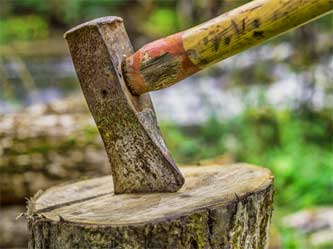
Firewood
May 29, 2025
I toyed with the idea of titling this simply 'fire' as, for small screens, it would be four less letters on the menu. But it is in fact the fuel that is at the heart of this business. And 'this business' is about keeping the engine running, the fire burning, the wheels turning. The burning consumption that seems to drive much of life. But we'll get back to that. Winter is not far away here in New Zealand and one of my projects is firewood; the sourcing, cutting, splitting, transporting and stacking, ready for the colder months. It is quite an operation.
There are a large number of wilding pines on the monastery property and while the wood doesn't burn so hot it is certainly plentiful. The trees are felled by various people (not monks) and the work of dissembling an entire tree is probably the most arduous, complex and dangerous part of the whole process. The trunk rarely falls flat to the earth so there are several tonnes of wood suspended in the air resting on downward branches spiked into the ground. Determining which branches are carrying the load is the most crucial task and being crushed by a collapsing tree is best to be avoided. An 18" chainsaw weighs about 6kg with a considerable power output. The chain can cut limbs (excuse the pun), it can grab and pull you forward, it can kick back and take off your face, or at least give you a nasty fright in that direction.

So back to 'this business' this me/you life business – dissembling the various angular contusions of the mind. The sheer weight of it all can sometimes appear daunting, questionably balanced, scary and overwhelming. Begin small. Perhaps, analogously, just trim a few of the easily accessible, smaller branches with a handsaw? The important thing is that the need to undertake the work is seen and that one begins with the intention to continue to completion. Winter is coming and past experience has given me a clear appreciation of the benefits of doing this – and that – work.
Splitting the cut logs is just another stage in dissembling. Various tools can be used; a hatchet, machete or other smaller whacker/cutter to trim any remaining bits-sticking-out as they snag when trying to put them in the stove. A set of wedges can be a useful aid. And a good two-handed axe or a dedicated splitting maul is all great exercise! We had a really gnarly old pine some years back and felt is was good grounds for getting a powered splitter. Awesome! Becoming familiar with the relative benefits of each tool is important. Those contusions? What is the best tool? A nicely honed metta (loving-kindness) can be really useful to work with some of your awkward sticking-out bits. Patience – pacing ones efforts (samma vayama) - allowing that a particularly gnarly contusion you have may take a long time to dissemble. Take time to investigate (dhamma vicaya) and understand which bits are most usefully worked on, let go of, first. And studying how the 'grain' runs, where is the best line of cleavage, the best point of entry for clean severance; raise the axe with confidence, bring it down with an even swing and make a clean cut - right through to the chopping block. Swing too soft and the axe gets stuck part way into the log - too hard and the axe can get buried in the chopping block. So, a patient and balanced effort - working with determination (adhiṭṭhāna) - to clearly know the work that needs to be done, and making a commitment to do it.

Ajahn Thanissaro wrote a book - Mind Like Fire Unbound - that wonderfully considers nibbāna in relation to its literal meaning: the extinguishing of a fire. He says: "fire is caused by the excitation or agitation of the heat property. To continue burning, it must have sustenance, (fuel, upādāna – literally: clinging, grasping)". Detachment, splitting off, severance, letting go, requires a relaxation of the relationship, the bond. The entanglement that binds the fibres of a piece of wood together need to be separated, relaxed, opened up. If you have a relatively short, even grained log this can be done gently, with minimal effort. If you have an old, gnarly, knotty issue in mind then it really needs to be understood well before applying effort; strike in the wrong place and the axe flies off and whacks you on the shin, or worse. Be kind, be compassionate, be patient but... be resolute. That sucker is going in the fire! Literally, in the context of the wood, or metaphorically in the sense of our attachments – which can, with practice, just be laid aside, let go of. And what is your fuel? What do you burn dependent on - what are you addicted to? What is your 'habit'? Try searching 'common bad habits' and see how many fit you? And there are also many good habits but it is behaviour that harms self and others that needs to be let go of.
The fire is a dynamic, active, life-element. When visible we see it as clinging, being bound to, some kind of fuel. When the fuel is exhausted or the flame lets go of its fuel the fire is freed, released – but not annihilated. The simile is not suggesting we identify with fire as some kind of life-force, some kind of spirit or soul. It is an image of relationship to contemplate... where does the fire go? And... ultimately, what is the nature of the unconditioned, the mind of an arahant when the sense of self is seen as perceptually fabricated, empty, fugacious, evanescent... and, this is a BIG topic, so, in the meantime, back to the firewood.
Transporting is a fairly simple, logistic exercise with nothing too technical involved. The split wood is here and the wood shed is there... although, there are always variables. Do we get people to form a chain and pass it by hand? A couple of people with wheelbarrows? The quad ATV with a trailer? Me on my own just chucking it down the hill by stages? Having our fuel relocated from... sub-conscious and unaware to recognition and attunement does need to happen. Left where it is it just settles deeper. Good, trusted friends can really be helpful.

Stacking can be a bit of an art - at least I require it so - as opposed to just 'throwing it in the shed'. Barbarians! There needs to be older wood in one stack for this winter and green wood in another to be burned next season and, unless there is a physical wall between them, the stack needs to be self-supporting, to be independent. Don't you too? Building a vertical wall of split wood takes practice; interlocking, orientation and size selection. Simple and satisfying work. But I did forget one last item - kindling. A nice stash of all the collected up small bits left from the crash, smash and slice; waste nothing. Shorter, even grained parts of a log can be set aside for kindling - the delicate split - the kind-ling. Paring off slivers the size of your finger can be tricky and be careful that your finger doesn't join the pile :(
All stages require undistracted attention (sati sampajañña), deft hand-eye coordination. And the overall result... sitting in my kuti with the kettle gently bubbling. Meditating, drinking a hot beverage with the warmth of a quiet friend engendering a calm sensitivity and a softening of time. A silent dialogue with nature. Cosy.
Reading what others say about firewood, I discover that since about 2019 one can be lumbersexual. Funny old world. I also came across a book called: Norwegian Wood by Lars Mytting - Chopping, Stacking, and Drying Wood the Scandinavian Way.
And here are some canonical references:

Upādāna Sutta (SN 12.52) Craving increases when you linger on pleasing things that stimulate grasping, illustrated with the simile of a bonfire.
Upādāna Sutta SN 45.173
“Bhikkhus, there are these four kinds of clinging (upādāna). What four?
- Clinging to sensual pleasure, (kāmupādāna)
- clinging to views, (ditthupādāna)
- clinging to rules and vows, (rites, rituals, etc. with the delusion that they suffice) (sīlabbatupādāna)
- clinging to a doctrine of self. (atta-vādupādāna)
The Noble Eightfold Path is to be developed for direct knowledge of these four kinds of clinging, for the full understanding of them, for their utter destruction, for their abandoning.”
Sammaditthi Sutta M9 (the section on clinging) = "When a noble disciple has thus understood clinging... the cessation of clinging... he here and now makes an end of suffering. ...and has arrived at this true Dhamma".
Adittapariyaya Sutta: The Fire Sermon uses the harmful nature of fire in the context of the three roots: passion, aversion, and delusion. It considers the dependent (addictive) nature and limitations of sense experience through which one develops disenchantment (nibbida), a weariness with the endless pursuit of 'fuel'.
